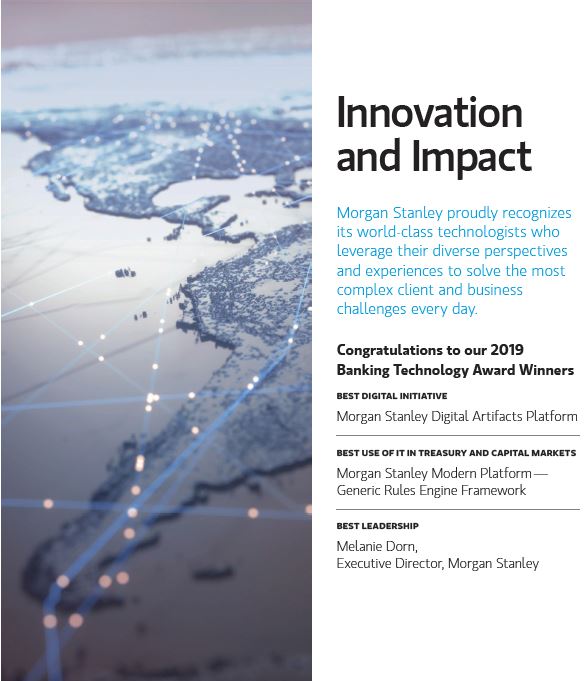A culture of innovation
SPONSORED INSIGHTS

The Firm Wins Best Digital Initiative, Best Use of IT in Treasury and Capital Markets, and the Tech Leadership Award
Morgan Stanley’s sweeping win of three Banking Technology Awards, paired with three high commendations in other categories, is not a coincidence. It’s a testament to its culture and commitment to innovation, says Sal Cucchiara, chief information officer and head of technology for wealth management at the firm.
Congratulations to Morgan Stanley on winning three Banking Tech Awards this year. What’s the recipe for your success?
We are thrilled about the recognition and so proud of our teams. Our success is defined by the outcomes and impact we deliver jointly with our business partners. Our key priorities are to deliver easy-to-use, innovative products that delight our three million wealth management clients and enable our 15,000 financial advisors to serve our clients. You can only drive this scale and type of innovation if you have the right mindset, people, and tools in place. And it starts with investing in diverse, high-caliber talent to foster technical excellence and a breadth of experience and perspectives.
Melanie Dorn’s recognition with the Tech Leadership Award seems to be a clear reflection of that.
Absolutely. She is a visionary leader who completely transformed two massive-scale, foundational technology programs that positively impacted our entire field organisation – financial advisors and their client service associates. Alongside this critical work, Melanie also commits her time to advancing our people and culture. She’s a leader in recruiting women developers and a strong advocate for our Technology Return to Work program, where she has doubled the number of participants in her first year of engagement. She’s a true role model and a positive force for leadership, transformation, technology, our business, and our workforce.
Earlier, you mentioned scale. How do you innovate with impact in such a large organisation?
Finding new ways to leverage common capabilities across all platforms is key, which we did with our Digital Artifacts initiative that won the Best Digital Initiative category. It was an answer to a bigger question about how we could best support information management for a massive organisation. Morgan Stanley Digital Artifacts now hosts around 50,000 documents that are centrally controlled, stored, versioned and indexed. But it has evolved into much more than a central resource. It also offers insights around application support, requirements, design collaboration and production outages, allowing our tech and ops teams to engage with their relevant book of work in a much more personalised way while eliminating manual processes.

Morgan Stanley award winners and teams.
Your Generic Rules Engine (GRE) framework won Best Use of IT in Treasury and Capital Markets. Tell us more about that.
We process over a hundred thousand orders for our Brokerage and Advisory platforms daily, across nearly 100 systems with multiple micro-services, vendor applications, operating systems and external partners. Any given equity has anywhere from 200-300 business rules governing it – on top of many data services. We used to have those business rules hard-coded into each individual system. With Generic Rules Engine, we created an externalised framework that holds all of these rules in one place. This allows us to save an incredible amount of code and developer time, not to mention cost. It’s this kind of holistic, integrated thinking and business-centric innovation that we are proud of cultivating.
This article is also featured in the February 2020 issue of the Banking Technology magazine.
Click here or on the banner below to read the digital edition – it is free!











































